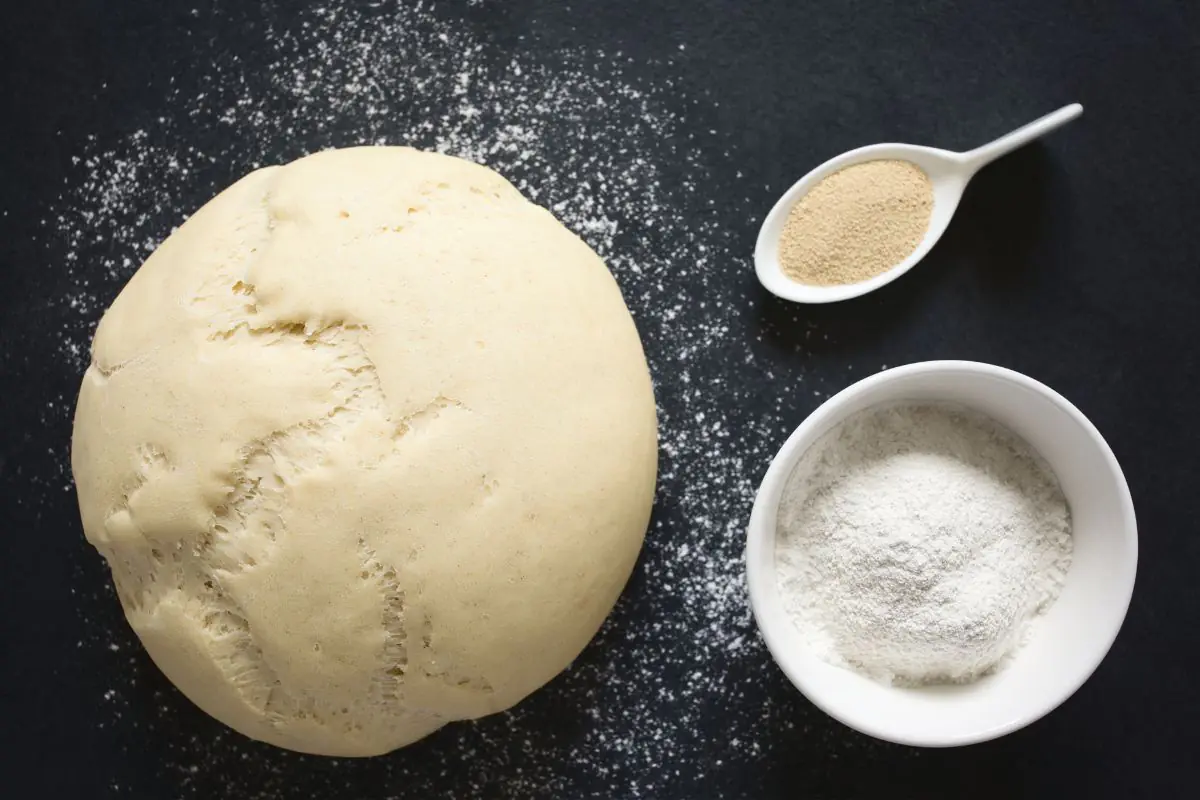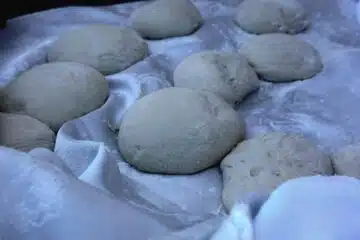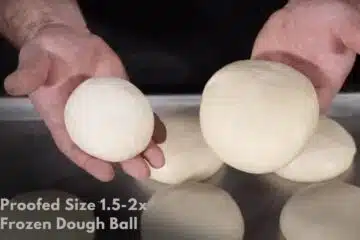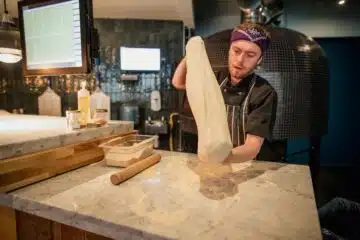To make pizza dough without yeast, combine equal parts flour and Greek yogurt. Mix until the dough forms a ball, then knead and roll out as desired.
Crafting homemade pizza dough without yeast is a straightforward process that caters to those with dietary restrictions or those simply out of yeast. This no-yeast alternative relies on kitchen staples and can provide a delicious base for your favorite pizza toppings.
The combination of self-rising flour with Greek yogurt creates a quick dough that requires no rise time, meaning your pizza can go from bowl to oven in minutes. This method is perfect for spontaneous pizza cravings and offers a healthier take on a classic dish, maintaining a satisfying texture and taste. The simplicity of the ingredients also means you can tweak the dough to suit your preferences, whether you’re aiming for a thin crust or something more substantial.

The Quest For Yeast-free Pizza Dough
Many pizza lovers embark on a journey for the perfect homemade pie. A key challenge? Crafting dough without yeast. This magical ingredient usually helps dough rise and gives it texture. But sometimes, yeast is not an option. Whether it’s due to dietary restrictions, allergies, or simply a lack of supply, yeast-free pizza dough is a sought-after solution.
Why Skip The Yeast?
Yeast allergies are one reason to avoid it. Quicker preparation times make yeast-free recipes appealing, too. Some seek healthier alternatives to traditional pizza dough. Others might need more time or access to yeast. No matter the circumstance, yeast is not essential for delicious pizza dough.
Popular Uses For Yeast-free Dough
Yeast-free dough is not just for pizza. Its versatility means it’s just right for multiple recipes:
- Quick flatbreads: perfect for dipping or pairing with meals.
- Wraps and rolls: ideal for lunches or snacks.
- Homemade crackers: crisp and customizable to taste.
Yeast-free pizza dough also becomes a canvas for creativity. Top it with classic favorites or explore new flavors. The possibilities are endless.
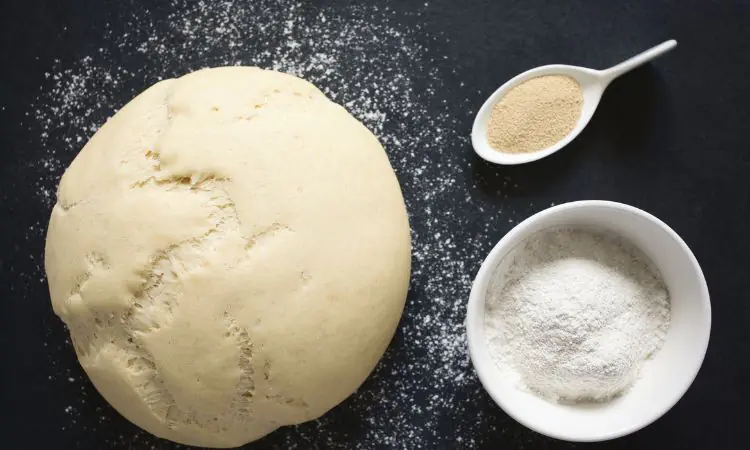
Gathering Your Ingredients
Starting your yeast-free pizza dough begins with the right ingredients. Imagine a canvas awaiting strokes of genius. With simple items found in your pantry, create a masterpiece. Here’s what you need.
Flour: The Foundation
Flour gives structure to your dough; for an ideal crust, whole wheat or all-purpose flour works best.
- 2 cups flour – The base of your dough
- extra for dusting
Leavening Alternatives To Yeast
No yeast? No problem. Baking powder and baking soda could be the heroes in your recipe.
| Leavening Agent | Quantity |
| Baking powder | 1 tbsp |
| Baking soda | 1/2 tsp (optional if using buttermilk) |
Binding And Flavoring Add-ins
Add-ins give the dough its delicious taste and perfect texture.
| Add-in Type | Ingredients | Quantity |
| Binding | Plain Greek yogurt or Milk | 3/4 cup |
| Flavoring | Salt | 1 tsp |
| Flavoring | Sugar | 1/2 tsp |
| Flavoring | Olive oil | 2 tsp |
Mixing The Perfect Dough
Mixing dough for pizza can be simple, even without yeast.
Making perfect pizza dough means understanding your ingredients.
The Role Of Gluten
Gluten gives pizza dough its elasticity.
- Use all-purpose or bread flour for the best texture.
- Knead your dough to develop the gluten. This makes it stretchy.
Balancing Wet And Dry Components
Balancing your ingredients is crucial.
- Start with your dry mix: flour, baking powder, and salt.
- Combine wet ingredients: water and oil.
- Gradually add the wet mix to the dry, stirring constantly.
- Your goal is a firm but pliable dough.
The right balance means a great base for toppings.
You don’t need yeast to create delicious homemade pizza.
Kneading Techniques
Are you making pizza dough without yeast? The secret lies in the kneading techniques. It’s all about developing gluten to give the dough stretch and pliability. Here\u{2019}s how to do it!
By Hand Vs. Using A Mixer
Kneading by hand connects you with the dough. It’s a tactile experience. You’ll push, fold, and rotate the dough. On the other hand, using a mixer is faster. A dough hook attachment is needed to work the dough well.
| Technique | Pros | Cons |
| By Hand | Control, Feel, Tradition | Time, Effort |
| Using a Mixer | Speed, Ease | Less Tactile, Cleanup |
Signs Of Properly Kneaded Dough
You know the dough is well-kneaded when it’s smooth and elastic. It should spring back when poked. Another sign is the dough passing the “windowpane” test. Stretch a small piece out. You should see light through it without tearing.
- Smooth to the touch
- Rebounds when poked
- Fails to rip during the windowpane test
Resting And Rising Without Yeast
Making pizza dough without yeast is not only possible but also quite simple. The key lies in understanding how to allow the dough to rest and rise, even without the traditional yeast. This alternative process still gives your dough the necessary time to develop its flavors and texture. Let’s dive into how resting and rising without yeast works.
Optimal Resting Times
Much like traditional yeast dough, our yeast-free variety also needs time to rest. However, the duration changes due to the absence of yeast. For optimal results:
- Short Rest: Allow the dough to sit for at least 20 minutes.
- Medium Rest: A 45-minute rest improves texture.
- Long Rest: For maximum flavor, leave the dough for 2 hours.
Each rest period allows the gluten to relax, improving both taste and flexibility.
Creating The Ideal Resting Environment
To ensure your dough rises, even without yeast, the environment is crucial. Follow these steps to create the ideal resting conditions:
- Warmth: Dough rises best in a warm spot, around 75°F (24°C).
- Cover: A damp towel or plastic wrap prevents the dough from drying out.
- Consistency: Use the same resting spot to maintain a steady temperature.
Adhering to these guidelines, your dough will develop the right texture, be ready for baking, and yield a delicious pizza base.
Rolling And Shaping Your Crust
Perfect pizza starts with the crust. Rolling and shaping your dough is a fun step. You get to decide its thickness and shape. Let’s dive into the art of preparing a crust without yeast that will wow everyone!
Thickness Variation For Different Pizzas
The thickness of your pizza dough can alter your pizza’s texture and taste. A thin crust is crispy and cooks fast. A thicker base is soft and chewy.
| Style | Thickness | Texture |
| Thin Crust | 1/8 inch | Crisp |
| Regular Crust | 1/4 inch | Classic |
| Thick Crust | 1/2 inch or more | Chewy |
Tips For An Even Crust
Even crust is key for the perfect pizza. Here’s how to make yours great:
- Let dough rest before rolling. It relaxes the gluten.
- Use a rolling pin for a uniform thickness.
- Start from the center and roll outwards.
- Rotate the dough a quarter turn after each roll.
- Check for thickness by measuring with a ruler.
- For a round shape, trim uneven edges with a pizza cutter.
Remember to work with care and enjoy the process!
Baking Strategies
Making pizza dough without yeast requires unique baking strategies. A perfect crust is still achievable. The key lies in temperature control and the baking surface.
Oven Temperatures And Hot Spots
Oven temperature is critical for a well-baked crust. Many ovens have hot spots. To avoid uneven baking:
- Preheat your oven to 425°F (220°C) for at least 20 minutes.
- Rotate the pizza halfway through the cooking time.
- Use an oven thermometer to monitor the actual temperature.
Using A Pizza Stone Or Baking Sheet
The right surface is essential for a crispy crust. Two popular options:
| Pizza Stone | Baking Sheet |
| Preheat the oven. Absorbs moisture. Gives a crispy bottom. | No preheating is needed. Easier to handle. Use parchment paper for non-stick. |
For a stone, please place it in the oven during preheating. For a sheet, place the dough on it.
Flavorful Toppings And Combinations
Creating pizza dough without yeast doesn’t mean you miss out on flavor. The right toppings can transform your pizza into a taste sensation. Dive into the perfect pairing of toppings to match your unique crust. Discover how gourmet touches elevate your homemade pizza experience.
Pairing Toppings With Your Crust
A no-yeast dough calls for thoughtful topping choices. Think fresh vegetables, savory meats, rich cheeses. A crisp, thin crust pairs well with light toppings. This allows the crust to shine without getting soggy.
| Crust Type | Topping Suggestions |
| Thin and Crisp | Cherry tomatoes, basil, mozzarella |
| Thick and Hearty | Pepperoni, bell peppers, onions, cheddar |
- Thin Crust: Arugula and prosciutto, olive oil, shaved parmesan
- Thick Crust: BBQ chicken, red onions, cilantro, smoked gouda
Finishing Touches For A Gourmet Experience
Before serving, drizzle with high-quality olive oil and sprinkle with herbs like oregano or fresh basil. These simple steps make a world of difference and turn your pizza into a gourmet delight.
- Drizzle truffle oil over mushroom and goat cheese toppings.
- Add a handful of arugula and a squeeze of lemon for zest.
- Grate fresh parmesan over hot pizza for a melt-in-your-mouth topping.
Creative Twists On Traditional Pizza
Ready to explore the world of pizza without yeast? Let’s dive into the endless possibilities of creative pizza making. With the right twists, traditional pizza becomes a mouth-watering experience. Embrace new ingredients and methods to keep your taste buds dancing.
Gluten-free And Vegan Variations
Gluten-free and vegan pizza enthusiasts can rejoice. Here’s how to transform your dough:
- Use gluten-free flour blends like rice, almond, or chickpea flour for your base.
- Add xanthan gum if needed to help the dough bind without gluten.
- Choose plant-based substitutes for cheese, like cashew or almond cheese.
- Top your pizza with fresh veggies or vegan meats for extra flavor.
Remember to roll your dough thinly to help it cook properly without yeast.
Dessert Pizzas Without Yeast
Who says pizzas must be savory? Dessert pizzas are a sweet sensation:
- Start with a simple base using flour, baking powder, salt, water, and a touch of oil.
- Pre-bake the crust until almost done to hold sweet toppings.
- Spread a sweet sauce like Nutella, jam, or cream cheese frosting over the base.
- Add fresh fruits, chocolate chips, or nuts.
- Finish off with a sprinkle of cinnamon or a drizzle of honey.
For a twist, use rolled oats or a graham cracker crust for a different texture.
Storing And Reheating Leftovers
Storing and reheating leftovers ensures that you can enjoy your homemade yeast-free pizza again. Proper storage keeps pizza fresh, and the right reheating technique brings back the pizza’s delightful crunch. Follow these tips for the best leftover pizza experience.
Best Practices For Freshness
Cool the pizza dough without yeast first to keep it fresh. Never store warm pizza in a container, as it can cause sogginess.
- Use airtight containers to prevent air from drying out the pizza.
- Wrap slices in aluminum foil before placing them in containers.
- Store in the refrigerator for up to three days.
- For longer storage, freeze pizza slices on a baking sheet and then transfer them to freezer bags.
Recreating The Perfect Crunch
For that fresh-out-of-the-oven taste, proper reheating is key.
| Method | Steps | Tips for Crunch |
| Oven | Preheat oven to 350°F. Place pizza on a baking sheet. Heat for 10 minutes. | Use a preheated baking stone or place the pizza directly on the oven rack for added crunch. |
| Skillet | Warm a non-stick pan over medium heat. Add pizza. Cover and cook for a few minutes. | Let the pizza sit for a minute after heating. This step allows the crust to crisp up further. |
| Toaster Oven | Set the toaster oven to medium. Place pizza inside and heat until warm. | Toast on a light setting to avoid burning the crust while allowing it to crisp. |
Avoid microwave use for reheating, as it makes the pizza dough chewy rather than crunchy.
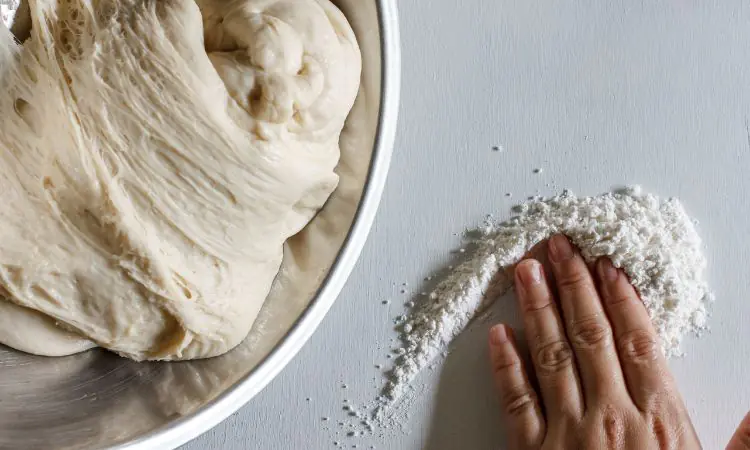
Frequently Asked Questions
What Can You Use Instead Of Yeast In Pizza Dough?
You can substitute yeast in pizza dough with baking powder, baking soda with acid, or a sourdough starter. Each alternative provides leavening to create a light, airy crust.
What Happens If You Don’t Put Yeast In Pizza Dough?
Without yeast, pizza dough will not rise, resulting in a dense and flat crust. The final texture will be tough rather than light and airy.
Can You Make Dough From Flour And Water?
Yes, you can make dough with just flour and water. The mixture can create a simple base for recipes like flatbreads and pasta.
Is It Okay To Make Dough Without Yeast?
Yes, making dough without yeast is possible. To create quick breads and cakes, opt for baking powder or soda as leavening agents. These substitutes help the dough rise without yeast.
Conclusion
Crafting yeast-free pizza dough can seem daunting at first. With these straightforward steps, you’re now equipped to enjoy homemade pizza anytime. Embrace the art of mixing, kneading, and rolling your dough to perfection. Savor the satisfaction of pizza night, all without the need for yeast.
So, heat your oven and indulge in your delicious, handcrafted creation. Happy baking!

As the author of the “Ultimate Pizza Guide: Recipes, Tips & Secrets Revealed,” I’m dedicated to sharing my love for pizza and empowering others to create delicious homemade pizzas with ease. Join me on a journey to uncover the secrets to perfecting your pizza game!
